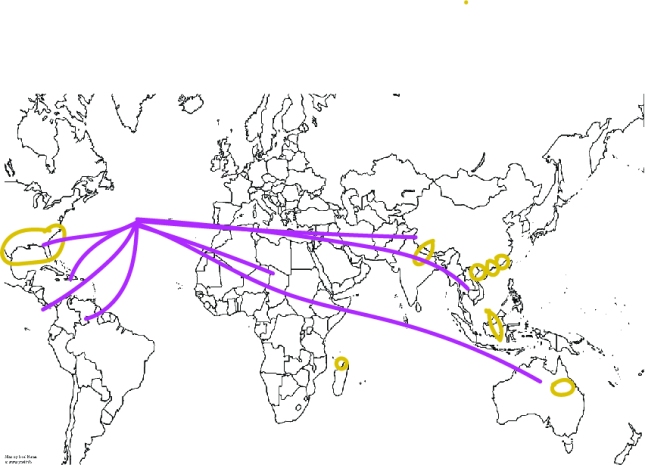Mitreola petiolata
(Mitreola means little mitre, because the fruit looks like a Bishop’s mitre. Petiolata indicates the leaves have stalks.)
Loganiaceae
Mitreola petiolata is a worldwide warm-climate weedy species whose point of origin and history of dispersal is unknown. Its intercontinental range include all of Florida. Let’s call it a native species.

That huge pantropical distribution stands out in the small genus Mitreola where most of the other species have narrow ranges scattered in Africa. Asia, Australia, Borneo, and Madagascar. Mitreola sessilifolia, similar to today’s species, ranges across Florida and much of the southern U.S., extending into Mexico.

Each yellow circle represents one Mitreola species. Mitreola petiolata is “everywhere,” the purple lines showing its global reach.
Mitreola petiolata has pretty little white flowers with a curious donut of hairs partly blocking the flower’s throat.

Highly magnified. The flower is about 1.5 mm in diameter.
And speaking of curiosities, the pod is a two-horned “Bishop’s mitre.”


Pod
Weedy species such as this distributed far and wide often reproduce free of the need for a male plant and a separate female mate to establish together for cross pollination at each step during world conquest. Botanical imperialism is more efficient if you spawn alone. There are different ways to accomplish that. Mitreola petiolata uses extreme self-pollination within individual flowers.

Back in 1841 botanists John Torrey and Asa Gray noted, “the pollen tubes are often so copious, even in dried specimens, as to fasten the anthers to the stigma.” This observation is 178 years old, and I’ve never seen anyone record checking it out since. It is about time! This is going to be better than Geraldo Rivera opening Al Capone’s vault! Get ready!
Be patient one moment though, after almost two centuries the mystery will hold 30 more seconds while a little background refresher may help explain what those two were talking about. In a “normal” textbook species, a bird or bee transfers some dustlike pollen grains from the pollen-producing anther of one flower to the pollen-receptive stigma of another flower. Then a tiny thread called the pollen tube grows like a root from the newly landed pollen grain down through the stigma and style to the ovary, carrying sperm to fertilize the baby seeds there. To repeat, the pollen tube is a tiny sperm-bearing filament extending from the pollen grain to the baby seed within the newly pollinated flower. Here is a helpful diagram:

Textbook normal pollination. Pollen grain (yellow) deposited onto stigma (blue) by pollinator. Then pollen tube (yellow) snakes down to deliver sperm to seed (violet).
Okay then, we now can carry forward knowingly. Mitreola petiolata has a ring of five pollen-making anthers attached inside the flower. The anthers unite to form a cap covering the stigma The pollen grains inside those anthers do something weird, they all sprout pollen tubes while still inside the anthers that made them. Today’s species skips the messy business of birds, bees, and pollen transfer to a different flower.

Top image: diagram of the Mitreola petiolata flower. Middle image: anthers (yellow) united into cap over stigma. Bottom: anther cap has been pulled away from stigma revealing pollen grains and their pollen tubes penetrating into the stigma.
The countless premature pollen tubes form a network lacing the anthers to each other and to the stigma in a wild orgy of self-pollination. When this has occurred, as Torrey and Gray noticed back the year President William Henry Harrison died in office, the mob of pollen tubes have stitched the anther cap firmly to the stigma.

This is the base of the flower with the petals removed. The anther cap (gray above the center) is tied to the stigma hidden beneath it. The 3 white flaps are anther attachment points left behind when the petals were torn away…remnants of the petals and their connections to the anthers. This photo shows the same info as the middle image in the diagram above.
When the anther cap is yanked away from the stigma under a microscope, the stigma remains covered with pollen tubes burrowing in for sperm-delivery.

This is the stigma with the anther cap pulled off. The tangle on the left is a mass of pollen grains and pollen tubes left behind from the anthers, and penetrating the stigma. Extreme self-pollination! The style is the shaft in the middle, and the large body on the right is the ovary. This photo matches the bottom image in the diagram above.
I’ll bet every flower on every Lax Hornpod in every wet meadow around the Globe matures a fruit filled with self-fertilized seeds. It’s an inside job!
Linda Cooper
April 26, 2019 at 8:33 pm
I see these often in wet areas near streams or just popped up along wet trails but found out today they don’t need no ‘stinkin’ opposite sex’ to getbdown to business. Thank you for making it easy for me to understand.
theshrubqueen
April 27, 2019 at 8:38 am
Nice graphics!
Barbara Levy
April 27, 2019 at 1:01 pm
Use this one in Botany if you teach in the fall – for extra credit! Still need to reread to get the mechanics down!
George Rogers
April 27, 2019 at 5:52 pm
actually would fit into a botany lab…and easy species to find
Jenifer
April 29, 2019 at 12:06 pm
Well done, as ever! Thanks, Jenifer, Sebastian
George Rogers
April 29, 2019 at 5:12 pm
Thanks Jennifer!